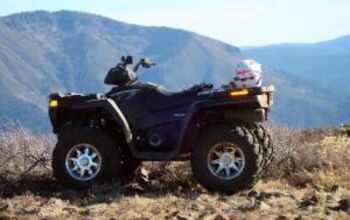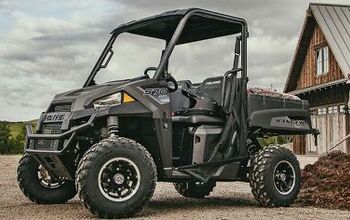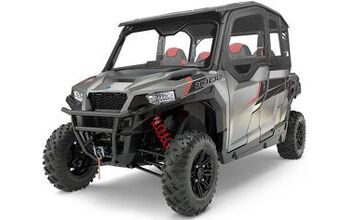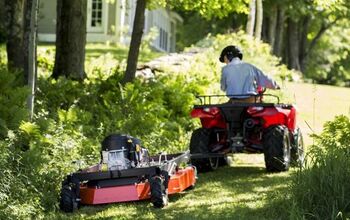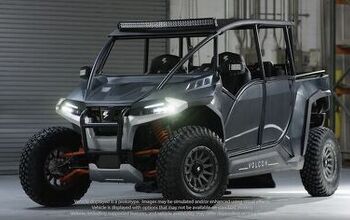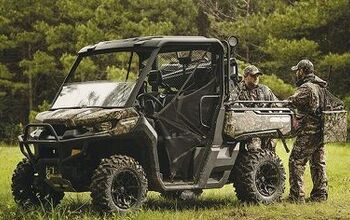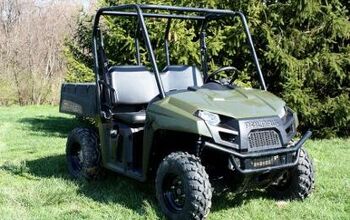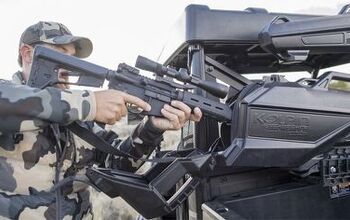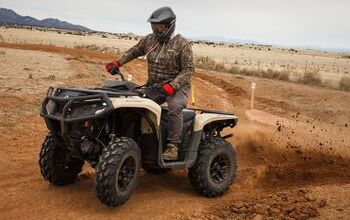2008 Polaris Sportsman 400 H.O. Review
The 300 class is the price point and power level at which many adult ATV buyers make their first purchase. Some riders never choose to buy anything bigger and brand loyalty starts to grow with the first purchase, so the quality of an OEM’s offering at this level is critical.
In model year 2006 Polaris released an all-new ATV called the Hawkeye. The Hawkeye initiated Polaris’ head-long charge into the 300cc market commanded by Honda. In typical Polaris fashion, the Hawkeye came with an independent rear suspension, rubber-belt CVT, clever styling, all-wheel drive and single lever hydraulic-disc brakes. Another critical asset was the price tag. Without a low sticker price, Polaris would’ve stood no chance at growing its sales in this market. Delivering all of the high-end features that the Hawkeye had at a competitive price was a coup for Team Polaris.
Polaris eliminated the Hawkeye name for 2008 to expand its Sportsman lineup. But the company is continuing its march into the 300-400cc class with a Sportsman 400 H.O. that is built on the original Hawkeye platform. The 400 H.O. has all the features and advantages of the Hawkeye, including a low retail cost of $5,599.
The 455cc engine isn’t a powerhouse, but it still makes for plenty of fun.
The 400 H.O.’s ace in the hole is a much stronger engine than the 300-cube found on the Hawk. The liquid-cooled, 455cc single-cylinder power plant is no stranger to Polaris fans. It was originally introduced on the 2006 Sportsman 450. In fact, it is a different version of the Fuji 425 and 500cc thumpers that Polaris has sold for years. The ‘Hawkeye’ chassis is lighter than the full-size Sportsman frames are, giving the 450 motor more freedom to propel the rider rather than merely pushing the chassis.
The re-named 400 H.O. is a dry sump design. It draws in air through a 34mm Mikuni carburetor. A simple pull-style choke cable mounted on the left handlebar is used for starting in colder temps. The mill does not dominate but it provides a satisfying ride. It makes this entry-level Sportsman a competitive performer in the 400 sport-utility segment and it should be very reliable, because many years of improvements are incorporated into it.
With a long winter transitioning to a late spring, I had the opportunity to ride the 400 for several weeks on trail conditions ranging from bitterly cold snowpack to freshly exposed spring earth. The H.O. is capable in both environments. The engine always fired up reliably. With the arrival of spring came the scent of cedar in the air and deluges of mud roosting from the rear tires. When real trail riding began it was apparent that this Sportsman handles well enough to deliver a lot of fun for the money.
A low center of gravity gives you lots of control on the trails.
The suspension allows seven inches of travel in the front and eight inches of travel in the back. It may not be quite as refined as the class-leading control on the bigger Polaris’, but the low retail price does not allow it to be. Even with the good suspension travel and ground clearance, the 400 does not feel top heavy. In fact, it rides as if the 33” seat height is even less than that.
The length of the vehicle is 72”, and the width is 45”. My observation is that the Hawkeye chassis is designed to meet the ergonomic requirements of small to medium build individuals. The chassis and body are approximately 13% smaller than the full-size Sportsmans. The spring pre-load settings also reflect this approach. Being six feet tall and weighting 200 lbs, I had to set the spring preloads to the 4th-stiffest setting out of five to control the roll in the corners. The size takes some getting used to after one has put in a lot of seat time on bigger quads, but this Sportsman grew on me. My guess is that anyone over 250 Lbs or 6’3” would be uncomfortable on the 300 and 400 H.O. Sportsmans, so they should look at the full size models.
As you can see, the 400 H.O. pulls through the mud just fine.
The HO pulls well through mud, with the light weight and aggressive tires helping it float, and it has good ground clearance for its class. The power delivery is reminiscent of a 300 Xpress – a 2-stroke ATV that Polaris manufactured in the 1990s. There is a sway bar linking both halves of the independent rear suspension. A simple handlebar switch lets the rider easily engage the drive shafts to the front wheels for true all-wheel-drive when the going gets tough. Like all Polaris’, the true AWD system on the 400 is hard to beat. The rubber-belt, Polaris variable transmission (PVT) has forward, reverse and neutral gears. This Sportsman is not designed for the food plot or snow plowing markets, so the lack of low gear is not much of an issue. The CVT delivers decent acceleration with the power curve stretched out somewhat more toward the high end rather than the low end. The designers at Polaris integrated the CVT and the gear case into one assembly. This integration no doubt helps keep weight and cost down.
The CVT couples modest engine braking to the rear two wheels to make downhill riding safer. For example, entering a 50-degree descent about 50 yards long, the Jake braking decreased the speed about five mph with no brakes applied before reaching the bottom of the hill. The excellent hydraulic brakes squeeze two disks in the front and one on the rear. One standout feature of the binders is that they were absolutely silent, even after being driven through water and mud. Silence is golden when it comes to brake operation and Polaris has achieved tremendous results in this area.
The bottom of this Sportsman did not look this clean after its mud bath.
There are some solid utility features on the Sportsman 400 H.O., including a 750 lb. towing rating and a receiver hitch in the back to make this job easier. When towing a trailer with its own brakes, the towing rating leaps to 1,786 lbs. The composite front rack is rated to carry 70 lbs and it opens up clamshell-style to provide a storage area similar to that found on the other Sportsmans. The rear rack is rated to haul 100 lbs.
One design flaw worth pointing out is the lack of front-end protection. There are no CV boot shields and the wiring for actuating all-wheel drive in the front diff is vulnerable to stick intrusion. Protection for these areas would not be very expensive to add. Clearly the bean counters, not the test drivers, asked for this protection to be eliminated.
The gas tank holds a respectable 4.5 gallons and a mechanical float gauge tells the rider how much fuel is available. There is a digital gauge incorporating a speedometer, trip meter and hourmeter. The gauge gives this entry-level ATV a little more cachet than quads with mechanical gauges. The Sportsman allows optimal winch mounting and there is enough room under the fenders to up-size the stock 24-inch tires. Red, green and Mossy Oak color options are available for the 400 H.O.
Polaris has developed a fully-equipped entry-level ATV in the 2008 Sportsman 400 H.O. It’s a capable trail conqueror at a competitive price. To learn more, check one out at your local dealer or visit http://www.polarisind.com/.
Related Reading:
More by ATV.com Staff
















